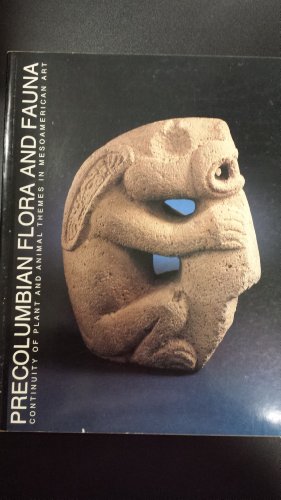Items related to Precolumbian Flora and Fauna: Continuity of Plant and...

Guest-curated by Jeanette Favrot Peterson, Ph.D., Latin American Art historian.
This exhibition included ancient and contemporary Mesoamerican sculptures in stone, ceramic, jade and wood. On loan from thirty-one museums and private collections, these objects express man's symbolic use of natural forms.
Includes essay by Jeanette Favrot Peterson "Flora and Fauan as Metaphor in Precolumbian Mesoamerica."
"synopsis" may belong to another edition of this title.
Man has always had a sense of affinity and even identity with the animal world. Among people who interact with their natural environment on an intimate, survival level, however, this fascination is converted into a dynamic relationship often expressed in metaphorical language. Man sees reflected in nature his or her own human characteristics and behavior A metaphor is a verbal acknowledgment for this implied likeness or analogy.
Metaphors can also be expressed visually, as is evident in pre-Columbian art. The fleet-footed deer, a primary source of meat in Mesoamerica, was an animal metaphor for the hunter and warrior. The black, blood-sucking bat was symbolic for death and sacrifice. Pre-Columbian man used animals to understand and order natural phenomena. Conversely, nature provided models to clarify and shape the social world and cosmos. When the day sun disappeared beyond the western horizon, it traversed dark regions below the earth. As the day sun, it flew across the sky as an eagle or falcon, but as the night sun, it prowled the underworld as a fierce nocturnal jaguar.
Metaphors that draw parallels between the human and natural worlds generate "culturally coherent bundles of meaning'' (Isbell 1985:287). In a three-way relationship, the eagle for the Aztec served as metaphor for sun and for ruler, thereby simultaneously relating the king to the solar divinity. Likewise, the image of the waterlily had many levels of meaning among the Classic Maya. The waterlily at once called up associations of the agricultural canals and the watery underworld. When the waterlily was worn as insignia by the Maya ruler, he became the provider of fertility and lord of the underworld. Among the classic Aztec, including the Nahua in central Mexico today, there exists a rich metaphorical tradition. Flora and fauna are one of several sources for metaphors which help to define not only human actions but the stages in the human life cycle. There are also metaphors for illness, curing, agriculture and earth, rulership, and founding myths.
Man's dependency on the environment gave rise to a sense of awe and respect for the entire universe. In the sixteenth century, the Dominican, Diego Duran (1971:290) remarked '' . . . even the bark of resinous trees was revered so that it would create a good fire . . . even large and small animals, fish, and tadpoles were adored and revered." The belief that all phenomena were animated by a life force formed a basis upon which more complex religious systems evolved.
Ancient societies structured their world view using plant and animal metaphors; they endowed their deities with powers symbolized by fauna and flora; their ruling elite borrowed from nature those characteristics they wished to emulate and control. Here we explore the selection and conversion of certain natural species into cultural signifiers by Mesoamerican man.
These ideas took form in a spectacular array of costume, architectural design, sculpture, and painting. Lost to us today are the many pre-Columbian artifacts originally created in ephemeral media, such as featherwork, wood, paper, and cloth. Fortunately, we can still appreciate pre-Columbian sculptures in clay and stone, including jade, their most precious material. These art works range in style from the powerful, naturalistic sculptures of the Aztecs to the esoteric imagery painted on Classic Maya vessels.
Mesoamerica encompasses most of present-day Mexico on the north and includes, moving southeast, Guatemala, Belize, and portions of Honduras, El Salvador, and northwestern Costa Rica. This vast geographic area incorporates many ecosystems. Nonetheless, Mesoamerica is considered a cohesive area culturally, bound through the sharing of such traits as the 260-day ritual calendar, the rubber ballgame, screen-style books and, most importantly, a view of the cosmos divided into three vertical layers, namely the sky, the earth, and the underworld (Gossen 1986:5-6).
"About this title" may belong to another edition of this title.
- PublisherMingei Intl Museum of World
- Publication date1991
- ISBN 10 0914155075
- ISBN 13 9780914155072
- BindingPaperback
- Edition number1
- Number of pages148
Buy New
Learn more about this copy
Shipping:
US$ 5.45
Within U.S.A.
Top Search Results from the AbeBooks Marketplace
Precolumbian Flora and Fauna: Continuity of Plant and Animal Themes in Mesoamerican Art
Book Description Paperback. Condition: New. In shrink wrap. Looks like an interesting title!. Seller Inventory # 100-23478
Precolumbian Flora and Fauna: Continuity of Plant and Animal Themes in Mesoamerican Art
Book Description Paperback. Condition: new. New. Seller Inventory # Wizard0914155075
Precolumbian Flora and Fauna: Continuity of Plant and Animal Themes in Mesoamerican Art
Book Description Paperback. Condition: new. New Copy. Customer Service Guaranteed. Seller Inventory # think0914155075
Precolumbian Flora and Fauna: Continuity of Plant and Animal Themes in Mesoamerican Art
Book Description Paperback. Condition: new. New. Fast Shipping and good customer service. Seller Inventory # Holz_New_0914155075
PRECOLUMBIAN FLORA AND FAUNA: CO
Book Description Condition: New. New. In shrink wrap. Looks like an interesting title! 1.6. Seller Inventory # Q-0914155075

